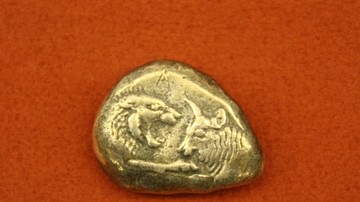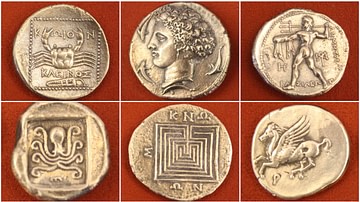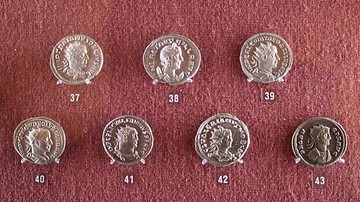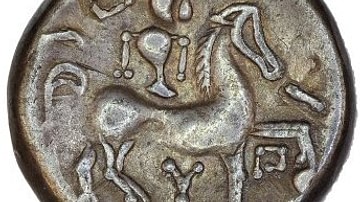Money may take many forms, from the digital code of cryptocurrency to the woodpecker scalps favoured in early California. People have also used cattle, cacao beans, cowrie shells, chewing gum, grain, and giant stones as money. Early cultures became especially fond of metals, particularly silver, gold, and electrum (an alloy of the other two). These held their value (unlike a dead cow), were easy to transport (unlike a giant stone), and they could be measured out in exact amounts and fractions (unlike a woodpecker scalp). The only problem with metals is all the weighing. This adds time to every transaction, increasing the inconvenience and costs of doing business with bullion. There had to be a better way – and the ancient Lydians invented it.
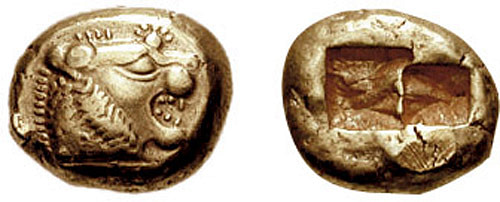
Lydians Invent Coinage
In approximately 630 BCE, someone in the Anatolian kingdom of Lydia stamped a piece of precious metal with something akin to a signet ring. One outcome of this simple act was that it increased confidence in the lump’s weight and purity when later used in the marketplace. This procedure did nothing to modify the intrinsic value of the commodity, but it simplified the exchange of bullion for anyone willing to accept the stamp’s guarantee prima facie rather than reweighing and retesting the lump every time it was traded. Merchants could set aside their cumbersome scales, weights, and touchstones to accelerate their transactions by counting out, not weighing out, this new form of currency. The Greeks, who quickly adopted this Lydian technology, named the coins nomismata because they functioned as money by accepted convention (nomos).
That acceptance probably grew by degrees. The first time a fellow showed up in a Lydian marketplace with some stamped chunks of electrum, most of his neighbors may not have noticed or cared. The metal went into the balance pan with other bullion to pay a debt or purchase a lamb. Nothing differentiated the stamped and unstamped pieces until people could agree, by custom (nomos), that the message punched into the metal had special meaning. At that point, the object obtained the three essential elements of a coin as later stipulated by Isidore of Seville in the seventh century CE: acceptable metal, weight, and design. The stamps were rudimentary affairs at first, bearing messages in Greek or Lydian stating, "I am the signet of Phanes" or "I am [the seal] of Kukas."
It must be remembered, however, that ancient peoples treated a seal more formally than we do a signature; the seal embodied the full power and prestige of the person associated with it. We might compare this to a document that has been notarized and not merely signed. These legends accompanied diverse images ranging from a lion to a stag, all hammered into the metal by a hardened die. Persons such as Phanes and Kukas (perhaps one a military commander and the other a king) stood surety for their stamped bullion in terms of its quality and quantity. Their prior involvement with the metal made it easier to transact business using it. To make this innovation even more convenient, coins were struck in seven denominations going down to a minute fraction (1/192) of a stater weighing less than a tenth of a gram (0.004 oz). This fact suggests a high degree of coin-based monetization, accommodating payments large and small across the Lydian economy.
State Coinage & King Croesus
What may have begun as a series of private acts assumed greater and greater public significance until it became a state monopoly. Lydian rulers stamped more and more coins into existence; just as importantly, they enforced compliance by virtue of their royal fiat. Experts often call these early royal coins croesids in honor of King Croesus, who governed Lydia from about 561 to 546 BCE. The innovation spread rapidly, probably abetted by the demands of Greek mercenaries for payment in money that could easily and quickly be spent or stored without losing its value. This explains why the Persians adopted coinage in those areas of their empire where they recruited and stationed mercenary soldiers.
Minting took hold more slowly in other regions of the Mediterranean, even those commercially active such as Egypt, Phoenicia, Carthage, and Etruria. The Romans did not issue a steady silver currency until the late third century BCE. Commerce did not create coins and coins did not create commerce; they simply worked together. Similarly, coins did not give rise to war, slavery, tyranny, or empire; coinage simply learned—as did poetry, art, and history—to take part.

Messaging on Coins
The ancients soon realized that the validating message pressed onto one side of a coin (the obverse) could be augmented by stamping an additional design on the other side as well (the reverse). This early step doubled the communicative power of coinage by placing outgoing messages on both faces. An analogy can be found in Mark Twain’s classic tale A Connecticut Yankee in King Arthur’s Court, where roving knights use their armor as multi-purpose billboards to spread public-service messages near and far. That notion is doubly communicated on a U.S. silver dollar showing one of Twain’s knights on the reverse. Today we might think instead of modern delivery trucks that have their daily tasks to perform in the marketplace. As long as they are traveling about anyway, carrying milk or crews of plumbers, why not also employ them as mobile signs?
Messaging on metal made coins something radically new—history on the outside with money in the middle. Once states took over responsibility for striking coins, they each experimented with this new medium. By and large, the Greeks placed the image of a patron deity, hero, animal, or mythological creature on their coins, such as Heracles (Hercules) strangling a lion for the mintages of Heracleia, a city named in his honor. Significant regional products and folk tales might also be publicized, such as Cyrene’s medicinal silphium plant or Tarentum’s eponymous hero Taras riding a dolphin. Coins might proudly carry the name of the issuing king or city, often abbreviated and sometimes with the initials or monogram of a local mint official. In rare cases, the artist who carved the dies signed his work, for instance the talented Euainetos responsible for the exquisite chariot racing coins of Sicily. Some famous designs gave their names to the coins themselves, such as the "owls" of Athens and "archers" of Achaemenid Persia, in much the same way as we speak today of "Benjamins" in America, "loonies" in Canada, and "kiwis" in New Zealand. The second-century CE writer Plutarch still knew that everyone, even the Spartans, called Athenian coins "owls" back in the fifth century BCE.

Significantly, most Greek money was made more beautiful than it needed to be for commercial use. In modern parlance, it was creatively packaged to please the consumer and promote the product. It brought to markets all over the ancient world a steady display of artistic skills. Measured lumps of traded metal were transformed into miniature masterpieces. Each die was hand-carved, and every coin was hand-struck; machine manufacturing of coinage would not arise until the seventeenth century. The high relief of ancient Greek coins, unlike the flatness characteristic of most modern money, gave them a remarkable sculptural quality that great artists could exploit. Although easily stackable, modern coins (with rare exceptions) do not stack up against their Greek forebears as three-dimensional art.
The competitive spirit of the Greeks may be better known in its athletic, military, political, and architectural forms, but coin-making stands out as well for quality and messaging. For example, numerous cities vied for recognition as the birthplace of Homer by depicting the poet on their coins.
Others sought to establish their connection to one of the Homeric heroes. The Macedonian town of Aeneia used its coins to illustrate the escape of Aeneas and his family from Troy. The design was later reprised on the propaganda coinage of Julius Caesar, who advertised his descent from the Trojan warrior Aeneas, son of Venus and Anchises, in order to ennoble his family’s origins. The claim to fame of the small town of Maroneia was that its eponymous hero Maron had supplied Odysseus with the wine that inebriated the dangerous cyclops Polyphemus, so its citizens proudly displayed a grape cluster on their coinage.

